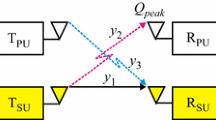Abstract
Recently, much attention has been drawn to distributed antenna systems (DAS), which are proposed to improve the performance of mobile communication systems. This paper focuses on the analysis of the average symbol error rate (SER) of DAS over a generic composite channel. Initially, a new composite channel model is considered for DAS, which is a mixture of path loss, lognormal shadowing and generalized-Gamma fast fading. This composite channel model is a generic model, which includes many well-known composite channel models as special cases. Based on the channel model, the cumulative distribution function of the output signal-to-noise ratio is obtained by employing selective transmission scheme. Moreover, by averaging the channel conditions and the positions of the MS in the cell, an approximate expression of the average SER is derived, which is a unified form of expression for many commonly used modulation schemes. Numerical results show that the derived expression of the average SER can provide sufficient precision for evaluating the SER performance of DAS under different modulation schemes.







Similar content being viewed by others
References
Saleh, A. A. M., Rustako, A. J., & Roman, R. S. (1987). Distributed antennas for indoor radio communications. IEEE Transactions on Communications, 35(12), 1245–1251.
Castanheira, D., & Gameiro, A. (2010). Distributed antenna system capacity scaling. IEEE Wireless Communications, 17(3), 68–75.
Akino, T. K., Molisch, A. F., Duan, C., Tao, Z., & Orlik, P. (2011). Capacity, MSE, and secrecy analysis of linear block precoding for distributed antenna systems in multi-user frequency-selective fading channels. IEEE Transactions on Communications, 59(3), 888–900.
Zhu, H., Karachontzitis, S., & Toumpakaris, D. (2010). Low-complexity resource allocation and its application to distributed antenna systems. IEEE Wireless Communications, 17(3), 44–50.
You, X.-H., Wang, D.-M., Sheng, B., Gao, X.-Q., Zhao, X.-S., & Chen, M. (2010). Cooperative distributed antenna systems for mobile communications. IEEE Wireless Communications, 17(3), 35–43.
Roh, W. & Paulraj, A. (2002). MIMO channel capacity for the distributed antenna systems. In IEEE 56th vehicle technology conference, Vancouver, Canada (Vol. 2, pp. 706–709).
Zhu, H. (2011). Performance comparison between distributed antenna and microcellular systems. IEEE Journal on Selected Areas in Communications, 29(6), 1151–1163.
Nikolopoulos, V., Fiacco, M., Staveou, S., & Saunders, S. R. (2005). Narrowband fading analysis of indoor distributed antenna systems. IEEE Antennas and Wireless Propagation Letters, 2(1), 89–92.
Simon, M. K., & Alouini, M.-S. (2005). Digital communication over fading channels (2nd ed.). New York: Wiley.
Matthaiou, M., Chatzidiamantis, N. D., & Karagiannidis, G. K. (2011). A new lower bound on the ergodic capacity of distributed MIMO systems. IEEE Signal Processing Letters, 18(4), 227–230.
Wang, J.-B., Wang, J.-Y., & Chen, M. (2012). Downlink system capacity analysis in distributed antenna systems. Wireless Personal Communications, 67(3), 631–645.
Choi, W., & Andrews, J. G. (2007). Downlink performance and capacity of distributed antenna systems in a multicell environment. IEEE Transactions on Wireless Communications, 6(1), 69–73.
Xiao, L., Dai, L., Zhuang, H., Zhou, S., & Yao, Y. (2003). Information-theoretic capacity analysis in MIMO distributed antenna systems. In IEEE 57th vehicular technology conference, Jeju Island, Korea (Vol. 1, pp. 779–782).
Chen, H.-M., Wang, J.-B., & Chen, M. (2011). Outage capacity study of the distributed MIMO system with antenna cooperation. Wireless Personal Communications, 59(4), 599–605.
Yang, L.-L., & Fang, W. (2009). Performance of distributed-antenna DS-CDMA systems over composite lognormal shadowing and Nakagami-m-fading channels. IEEE Transactions on Vehicular Technology, 58(6), 2872–2883.
Chen, H.-M., Wang, J.-B., & Chen, M. (2009). Outage performance of distributed antenna systems over shadowed Nakagami-m fading channels. European Transactions on Telecommunications, 20(5), 531–535.
Wingo, D. R. (1987). Computing maximum-likelihood parameter estimates of the generalized gamma distribution by numerical root isolation. IEEE Transactions on Reliability, 36(5), 586–590.
Shen, Y., Tang, Y., Kong, T., & Hai, S. (2007). Optimal antenna location for STBC-OFDM downlink with distributed transmit antennas in linear cells. IEEE Communications Letters, 11(5), 387–389.
Gan, J., Li, Y., Zhou, S. & Wang, J. (2009). On Sum Rate of Multi-User Distributed Antenna System with Circular Antenna Layout. In IEEE 66th Veh. Technol. Conf., Baltimore, MD, UAS, pp. 596–600.
Park, J., Song, E., & Sung, W. (2009). Capacity analysis for distributed antenna systmes using cooperative transmission schemes in fading channels. IEEE Transactions on Wireless Communications, 8(2), 586–592.
Feng, W., Li, Y., Zhou, S., Wang, J., & Xia, M. (2009, April). Downlink capacity of distributed antenna systems in a multi-cell environment. In IEEE wireless communications and networking conference (pp. 1–5). Budapest, Hungary.
Goldsmith, A. (2005). Wireless communication. New York: Cambridge University Press.
Abramowitz, M., & Stegun, I. A. (1970). Handbook of mathematical functions with formulas, graphs, and mathematical tables (9th ed.). New York: Dover Publications.
Burden, R. L., & Faires, J. D. (1989). Numerical analysis (9th ed.). Boston: PWS KENT Publishing Company.
Gradshteyn, I. S., & Ryzhik, I. M. (2007). Table of integrals, series, and products (7th ed.). New York: Academic Press.
Acknowledgments
This work is supported by Key Special Project of National Science and Technology (No. 2013ZX03003006), National 863 High Technology Development Project (No. 2013AA013601), National Nature Science Foundation of China (Nos. 61372106, 61102068, 61172077 & 61223001), Research Fund of National Mobile Communications Research Laboratory, Southeast University (No. 2013A04), Program Sponsored for Scientific Innovation Research of College Graduate in Jiangsu Province (No. CXZZ13_0098), Research Fund for the Doctoral Program of Higher Education (No. 20113218120017), Open Research Fund of National Mobile Communications Research Laboratory, Southeast University (No. 2012D14).
Author information
Authors and Affiliations
Corresponding author
Rights and permissions
About this article
Cite this article
Wang, JY., Wang, JB., Chen, M. et al. Average SER Performance of Distributed Antenna Systems Over Shadowed Generalized-Gamma Channels for Different Modulation Schemes. Wireless Pers Commun 75, 1099–1114 (2014). https://doi.org/10.1007/s11277-013-1410-7
Published:
Issue Date:
DOI: https://doi.org/10.1007/s11277-013-1410-7




